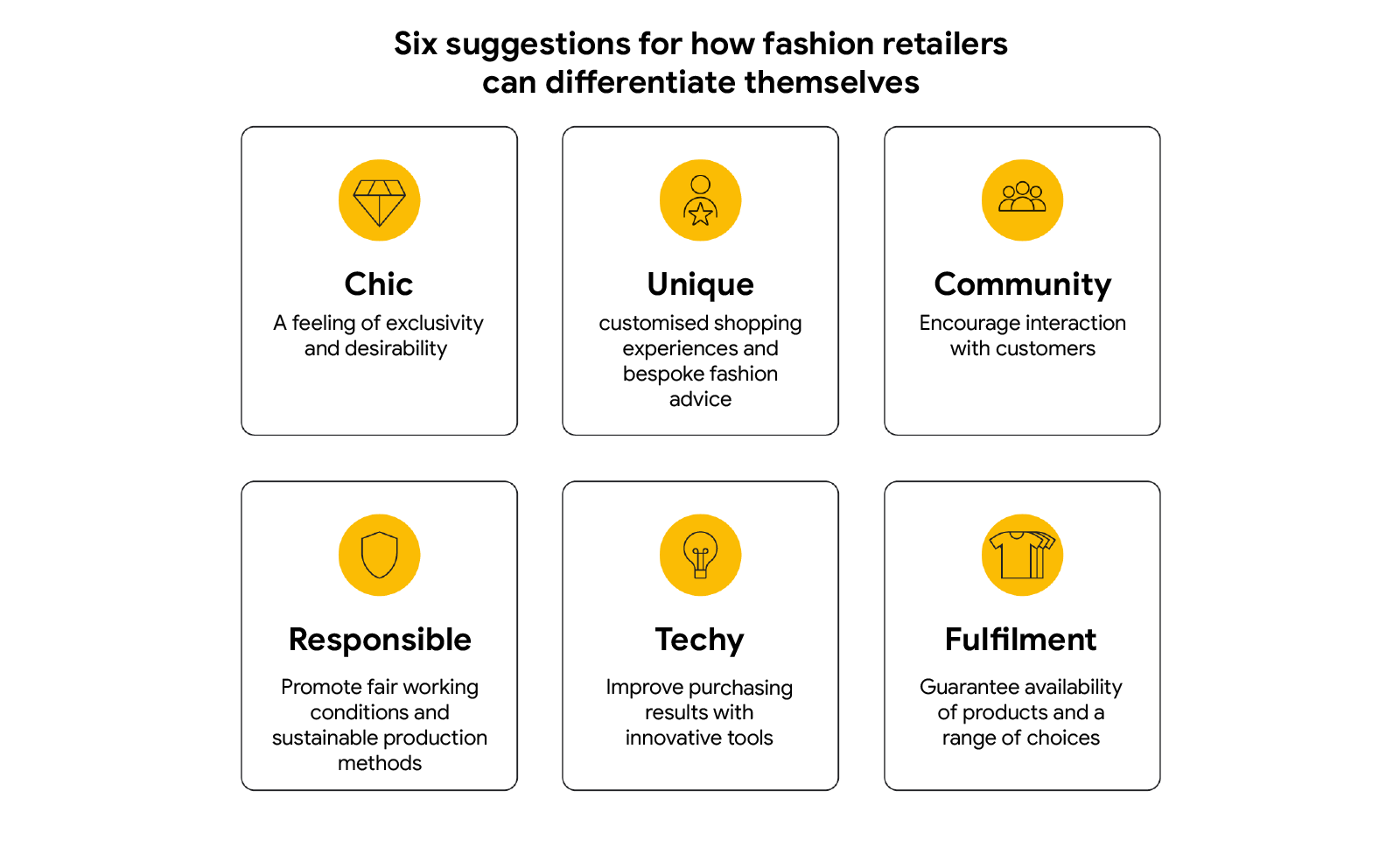The fashion market is facing enormous challenges. Some customers are still reluctant to spend money, and a wide range of options – both online and offline – has created a highly competitive market in which retailers have to prove themselves. The pandemic and economic uncertainties have also permanently changed shopping behaviour. Consumers are now more price conscious than ever, but are also wanting unique shopping experiences.
Differentiation is the key to long-term success for fashion retailers. A recent study carried out by Google and Kantar analysed over 250 brands and retailers in nine EMEA markets and surveying more than 9,000 consumers. It found that consumers feel overwhelmed by the sheer mass of products on offer. The study reveals that although consumers know an average of more than 26 different fashion retailers, they only shop regularly at eight.1
Retailers need to stand out in order to become customers' first choice. "Our study shows that multi-brand and multi-category retailers in particular need to sharpen their brand identity," says Claudia Denzel, retail director at Google Germany. "Retailers need to learn to think like brands."
But there is still room for improvement for brands seeking to stand out as unique or special. According to Kantar, shoppers only perceive a quarter of fashion retailers in Europe as differentiated.2 We also found a discrepancy between types of retailers. Three in 10 direct-to-consumer retailers are perceived as differentiated, compared to just one in 10 multi-brand retailers.3
Differentiation is rewarded with loyalty
It's worth taking a close look at unique selling points from several perspectives. While it's true that fashion retailers with a clearly recognisable USP are able to increase awareness of their brand, loyalty and trust among consumers, it also increases customers' willingness to pay higher prices and enables brands to optimise their margins.
But how can fashion retailers actively set themselves apart? Our analysis of successful fashion retailers identifies six core factors.
Six factors to help fashion retailers to differentiate themselves

- Chic: Retailers who choose being chic as their USP are known for introducing new styles and trends before the competition. They create a feeling of exclusivity and desirability through limited collections and frequently update their range to keep up with current trends.
- Unique: Retailers who value the individuality of their customers offer customised shopping experiences and bespoke fashion advice. Retailers can use customer information to tailor their marketing and product portfolio to individual preferences and behaviour. This includes personalised product suggestions, individualised marketing campaigns and tailored shopping experiences both online and offline.
- Community: Retailers that focus on community allow customers to interact with each other and share their experiences. Brands can encourage two-way communication and user-generated content. Influencer partnerships and peer-to-peer recommendations can be used to grab shoppers' attention and strengthen a sense of community.
- Responsible: More and more consumers are prioritising retailers who follow ethical production and environmentally friendly practices. Brands can capitalise on this by communicating transparently about fair working conditions and sustainable production methods. They can also position themselves in terms of resource conservation and environmental protection measures. Another consideration is inclusivity: by offering a diverse range of sizes and styles for all customer groups, retailers can emphasise their commitment to fairness and equality.
- Techy: Technological innovation also plays an important role in differentiating your brand. Retailers can score points here by using innovative online tools, smart search functions, an intuitive app, product reviews and price comparisons or AR applications that enrich the shopping experience and improve interaction with products.
- Fulfilment: Retails need to fulfil every offer advertised, from order to delivery. It's particularly important to be aware of the respective product availability and various options in terms of quality, sizes and prices.
Differentiation: Knowing your own strengths and customer needs
Retailers need to develop a clear differentiation strategy in order to survive in the highly competitive online fashion trade. "In the current globalised market, products alone are not enough," explains Stephan Tromp, Deputy Managing Director of German Retail Federation HDE. "Retailers need to use their strengths – quality, innovation, a customer focus, and sustainability – as their "DNA" in order to stand out and win over customers."
If retailers can identify strengths, know the needs of their customers, and keep an eye on current market trends, they can make targeted investments to differentiate themselves.

- Find your niche: Retailers need to focus on their strengths and know their competitors. Not everyone can excel everywhere.
- Communicate your strengths: Even successful retailers are often not perceived as being unique. They should therefore emphasise what makes them special.
- Putting your customers at the centre: Retailers need to know the style trends of their target group, create a sense of community and personalise the shopping experience.





